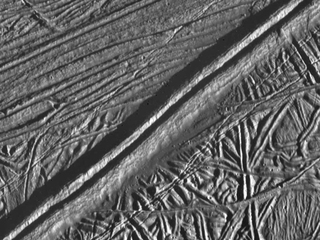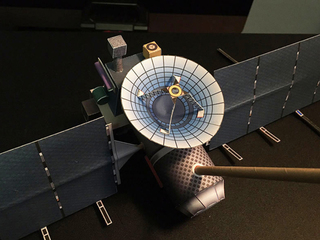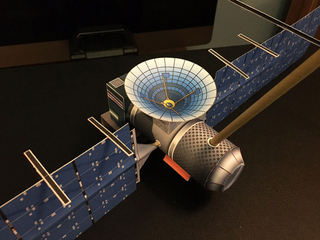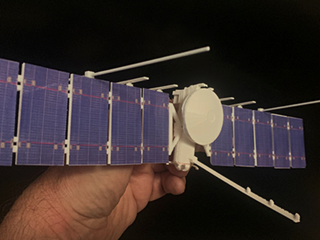Mission Updates | April 26, 2022
Mission Dispatch: Using Radar to Study Earth and Europa
Earth and Jupiter’s moon Europa have something in common: a liquid water ocean. Despite being one-fourth of Earth’s diameter, Europa likely has a subsurface ocean containing more than twice as much water as we have on Earth. But Europa’s ocean is hidden beneath a shell of ice thicker than any ice on Earth. How will Europa Clipper see through it to study Europa’s ocean?
Looking Into Earth’s Ice
Europa Clipper’s REASON instrument will peer through Europa’s ice with radar, seek the ocean below, and study the ice’s structure and thickness.
Only a handful of spacecraft have visited the solar system’s outer planets, and none carried ice-penetrating radar to view oceans below the surface. In addition to Europa Clipper, the European Space Agency’s JUpiter ICy moons Explorer (or JUICE) spacecraft will carry an ice-penetrating radar called the Radar for Icy Moons Exploration (or RIME) instrument. JUICE will launch in 2023 and arrive in 2031, and Europa Clipper will launch in 2024 and arrive in 2030.
While Europa Clipper and JUICE will be the first to carry this type of radar, it’s not a new technology. Ice-penetrating radar have been used by researchers to probe Earth’s ice sheets for over half a century. Researchers use ice-penetrating radar to study ice thickness, subglacial lakes, ice temperatures, the orientation of ice crystals within glaciers, and the topography and geology below ice.
“Ice and radar are an awesome combination,” says Gregor Steinbrügge, a planetary scientist at NASA’s Jet Propulsion Laboratory (JPL) and an investigation scientist for the REASON instrument. “Ice is very transparent to radar unless the radar hits something different. That is useful on Earth for measuring glacier and ice shelf thickness, and how they change over time.”
Ice-penetrating radar is more important than ever for monitoring Earth. “It shows us how glaciers and ice sheets are responding to climate change,” said Dustin Schroeder, a radioglaciologist at Stanford University and a member of the REASON science team. A radioglaciologist is someone who studies glaciers, ice sheets, ice caps, and icy moons using radar.
Researchers routinely fly planes with ice-penetrating radar over Greenland and Antarctica, whose combined ice sheets contain more than 99 percent of Earth’s freshwater ice. Ice-penetrating radars allow scientists to calculate the ice’s volume and how much oceans will rise as the ice melts. The radar observations provide essential inputs for computer models, allowing scientists to estimate future sea level rise and produce assessments for the Intergovernmental Panel on Climate Change (IPCC).
Looking Into Europa’s Ice
The study of ice on Earth and Europa has a shared lineage, Schroeder says. One of the ice-penetrating radar systems now studying Earth’s ice was developed in the 1990s as a test model for studying Europa–part of a collaboration between REASON principal investigator Donald Blankenship, at the University of Texas Institute for Geophysics, and REASON deputy principal investigator Alina Moussessian at JPL.
REASON investigation scientist Trina Ray of JPL is eager to examine the ice of an ocean world beyond Earth. “We never know what we’ll learn the first time,” Ray says. “The radar easily penetrates ice but doesn’t go through water, so we hope REASON will tell us clearly where the ice ends and Europa’s ocean begins.”
The thickness of the ice is a key factor to determine whether Europa could sustain life. Theory and observation suggest that Europa's icy shell is around 10 to 15 miles (15 to 25 kilometers) thick, overlying an ocean approximately 40 to 100 miles (60 to 150 kilometers) deep. Jupiter’s magnetic field hurls atomic particles at Europa’s surface, creating compounds that potential life, like microbes, might use. Thinner ice would help those compounds reach the ocean, improving the odds that Europa could sustain life.
Subsurface oceans are known or suspected in a surprising number of places in the cold outer solar system, including Jupiter’s other moons Ganymede and Callisto, Saturn’s moons Titan and Enceladus, Neptune’s moon Triton, and possibly Pluto. “It will be amazing to apply what we learn from Europa to the other ocean worlds of the outer solar system,” Steinbrügge said.
Schroeder says that comparing Earth and other worlds helps us understand each in greater detail. “We can observe Earth up close and understand it in great depth, which helps us understand other parts of the solar system. Likewise, studying processes on other worlds under different and extreme conditions helps us understand Earth.”






